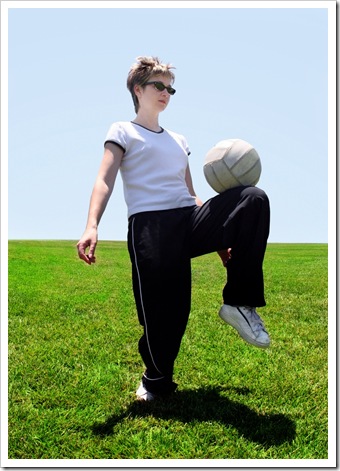
Let’s live healthier and more active longer. That alone has become the motto of our generations who may have reached our embracing years of our thirties and older. Our ability to want to play full out is fabulous as long as we maintain and take care our health and our bodies along the way. One such joint that has an extreme amount of wear and tear and can put us on the sideline quickly is our knee joints. Remember even old injuries to our knees that may have happened when we were in our twenties can come back to haunt us in our retirement years.
At the moment there is no time machine that can transport us back in time to avoid the injury, but there are some things we can do to help keep our knees from being prone to injury and keep us kicking strong for years to come.
Start Strong Knee Tips
1. Wear Proper Shoes – If your feet tend to roll to the inside or outside, or if you have fallen arches, it can affect not only your knees, but your hips and back. A proper assessment will determine if orthotics may be a suitable option for you. Orthotics should be properly fitted and customized to your needs.
2. Exercise Intelligently – This can be a particular problem with “weekend warriors” who feel they must fit in as much exercise as possible over the weekend because they don’t have time during the week. This can contribute to an overloading of the muscles, tendons and ligaments of the knee that are not accustomed to regular exercise, leading to an injury or even micro-tears that may not show up immediately, but could over time.
3. Lose Unhealthy Pounds – Any high-impact activities are extra hard on the knees if you are overweight. If you are overweight, running and other sports that have great impact on the knees should be avoided until you have achieved a normal weight. Practice other forms of exercise in the meantime that take the pressure off the knee, such as walking, swimming, and/or cycling.
4. Increase strength and flexibility – Concentrate on stretching and strengthening the hamstrings, quadriceps, hip flexors and the vastus medialis oblique (VMO) muscles, as these provide the greatest support to the knees and ensure that the knee tracks properly. Women are especially prone to improper tracking, which places more stress on the ligaments of the knee. This misalignment creates a popping or grinding sound when you bend the knee, often accompanied by pain. Incorporate Yoga and Pilates as they are a good way to keep the muscles, tendons and ligaments of the leg and knee strong and flexible.
5. Add Safe and Natural Chiropractic Adjustments and Rehabilitation– If your spine or hips are misaligned, the stress your knees have to bear is much greater. Sacroiliac and lumbar misalignments can make one leg shorter than the other, so your gait is not straight. Studies have shown that people who had knee pain due to muscle tightness showed there was a significant improvement of the condition in all subjects after having a chiropractic adjustment to the sacroiliac joint. Regular chiropractic care can help keep excessive strain off your knees and increase range of motion.
Futurepace Your Healthcare Solution!
Our expert team would like to be part of your future healthcare solution. We will address not only the areas that are affected by pain but help restore function to help your body obtain better long lasting overall health and strength naturally.
Call Today. We are Ready to Help!
For Your Health,
Dr. Ryan Moorman

 A
A